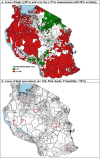Spatio-temporal modelling of routine health facility data for malaria risk micro-stratification in mainland Tanzania
- PMID: 37391538
- PMCID: PMC10313820
- DOI: 10.1038/s41598-023-37669-x
Spatio-temporal modelling of routine health facility data for malaria risk micro-stratification in mainland Tanzania
Abstract
As malaria transmission declines, the need to monitor the heterogeneity of malaria risk at finer scales becomes critical to guide community-based targeted interventions. Although routine health facility (HF) data can provide epidemiological evidence at high spatial and temporal resolution, its incomplete nature of information can result in lower administrative units without empirical data. To overcome geographic sparsity of data and its representativeness, geo-spatial models can leverage routine information to predict risk in un-represented areas as well as estimate uncertainty of predictions. Here, a Bayesian spatio-temporal model was applied on malaria test positivity rate (TPR) data for the period 2017-2019 to predict risks at the ward level, the lowest decision-making unit in mainland Tanzania. To quantify the associated uncertainty, the probability of malaria TPR exceeding programmatic threshold was estimated. Results showed a marked spatial heterogeneity in malaria TPR across wards. 17.7 million people resided in areas where malaria TPR was high (≥ 30; 90% certainty) in the North-West and South-East parts of Tanzania. Approximately 11.7 million people lived in areas where malaria TPR was very low (< 5%; 90% certainty). HF data can be used to identify different epidemiological strata and guide malaria interventions at micro-planning units in Tanzania. These data, however, are imperfect in many settings in Africa and often require application of geo-spatial modelling techniques for estimation.
© 2023. The Author(s).
Conflict of interest statement
The authors declare no competing interests.
Figures
References
-
- WHO, RBM . High Burden to High Impact: A Targeted Malaria Response. Berlin: WHO and RBM Partnership to End Malaria; 2018.
-
- Rouamba T, Samadoulougou S, Tinto H, Alegana VA, Kirakoya-Samadoulougou F. Bayesian spatiotemporal modeling of routinely collected data to assess the effect of health programs in malaria incidence during pregnancy in Burkina Faso. Sci. Rep. 2020;10:2618. doi: 10.1038/s41598-020-58899-3. - DOI - PMC - PubMed
Publication types
MeSH terms
Grants and funding
LinkOut - more resources
Full Text Sources
Medical
Research Materials
Miscellaneous



